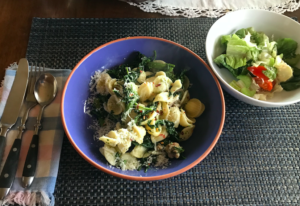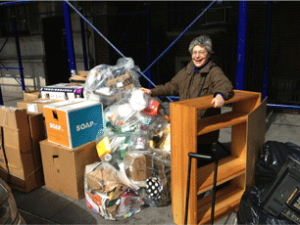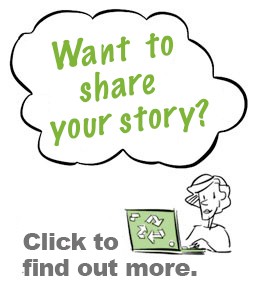
Pasta makes for tasty leftovers. Encore!
Leftovers represent a BIG part of all the food that goes to waste in America. Most of that food winds up in landfills, contributing to greenhouse gases when it degrades. WHY is this happening?
Reason #1: IGNORANCE. Many Americans just don’t understand where their trash gets taken “away” to, much less how many resources it takes to get food to their tables, or the impacts once the waste reaches a landfill.
Reason #2: LACK OF FOOD AND COOKING RELATED EXPERTISE. We don’t know how to plan meals, estimate correct portions, or understand the real meaning of “Best By” and “Use By” dates.
Reason #3: REFRIGERATORS: They are too big! It’s too easy to stash extra food, and leftovers keep getting lost in the back!
In order to get more people to eat leftovers, we need to first get them over three key barriers. One Barrier: Longstanding negative health associations of leftovers. Another Barrier: We are losing the habits and practices that helped us pass along cooking skills — and particularly the leftovers-related ones, within our society. Moms work, kids don’t learn how to cook in school, scouts or 4H. A Third Barrier: Eating up leftovers competes with more convenient (but less “beneficial”) disposal alternatives: trash and composting.
Three good opportunities:
1) Leftovers are cheap & convenient,
2) They have positive associations like nostalgia, warmth, sentiment;
3) They have influential advocates, like chefs, restaurant owners, other foodies
Good news! There are likely 50+ things that we can all do to help change leftovers history.Here are eight of them to get us started.
Strategy #1: Leverage the expertise and cachet of chefs and good home cooks: connect them with local food writers, Facebook groups, Instagram feeds, etc.
Strategy #2: Promote hip new restaurant entrees that leverage leftovers: “trash rice”, “chicken compost” “confetti casserole”; “encore pasta”. Require doggy bags; promote food donations
Strategy #3: Teach people the “matrix” of leftover dishes, many of which come from many different cultures and cuisines; Update for today
Strategy #4: Create new social occasions: Friday “must go” buffet, Leftovers pooling party; Post-holiday leftovers swaps
Strategy #5: Leverage community pantries, refrigerators
Strategy #6: Leverage Social Media: Facebook pages, Neighbor.com, BuildingLink.com
Strategy #7: Set a Good Example: Send home guests with leftovers; Bring reusable containers; Make leftovers matrix dishes for friends; Teach your kids to cook
Strategy #8: Advocate and Engage Others: Write a blog post on leftovers; Reach out to a local food writer with insights and stats; Publish your favorite leftovers recipe; Encourage good food use practices in local restaurants and cafeterias; Start a teach your kids to cook day
I have 42 more strategies — and am writing them all up in my new book. Watch out leftovers — I’m hoping to make you a thing of the past!




I have another one. Do it the old way; use from nose to tail and that counts also for vegetables.
After dinner the leftover skins and bones of a chicken go with cut-offs and peels of vegetables in a pot with water and simmer to make the best stock you can imagine. Concentrate and freeze in in icecubes for sauces etc.
I love the point about how refrigerators are too big. At home, my family’s leftovers are forgotten about in the fridge very often. I think it is such an important idea to get connected with others about their leftovers ideas. People won’t have to feel bad about not having a fancy new dish each night for dinner, they will actually feel excited about crafting something delicious by spicing up their leftovers! The leftovers community will applaud them!
I completely agree that there is a lack of education and understanding surrounding food waste in America. And, I really like how a lot of the solutions presented to popularize leftovers can be done on a smaller scale. It makes the overwhelming problem of food waste feel more manageable and encourages me to incorporate some of these solutions into my day-to-day life. I can’t wait to throw a leftovers party with some friends.
I think the lack of food and cooking related expertise is really quite troubling as I really believe it is a basic life skill which is also much more economically and environmentally sustainable. I am so lucky that I grew up surrounded by people that genuinely enjoyed cooking and food and therefore learnt a lot out of my own interest but I have personally seen how clueless some people my age can be when it comes to cooking simple dishes or buying good quality produce or goods. I wish instead of the somewhat redundant courses that we have to take in college there could be a course to do with basic food skills and nutrition facts or something like that!
In addition to the point made about leftovers contributing to greenhouse gas emissions, food waste, as well as food production waste (meat processing facilities), can negatively impact communities living in areas where this waste is dumped. This disproportionally impacts communities of color and low-income communities. If we can decrease the amount of food waste we produce by eating more of our leftovers and decreasing our demand for so much food, we may be able to combat these negative impacts we are having on members of our communities.
In addition to the impacts of food waste on greenhouse gas emissions, food waste and waste produced from food production (meat processing facilities) is an environmental justice issue. Negative environmental emissions from these two sources disproportionately impact minority communities as well as low-income communities. If we can reduce the amount of food waste we produce and the demand for so much food, we can decrease the harm that is done to these communities.